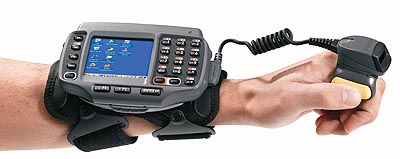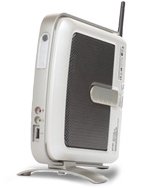 Rugged PC Review
Monthly News Archive
[ Back to news index] Rugged PC Review
Monthly News Archive
[ Back to news index]




|

|
October 2006
Panasonic improves bestsellers: Toughbook CF-19 and CF-30
Panasonic introduced two rugged Panasonic Toughbook computers: The CF-19 convertible Tablet PC, and the flagship CF-30 clamshell notebook. Building on the CF-18 tablet and CF-29 notebook, the new models come with Intel Core Duo processors, additional security features, and optional next-generation wireless data networks from all major cellular wireless carriers. In addition to the usual magnesium alloy cases, sealed keyboards and ports, flexible internal connectors and shock-mounting, Panasonic claims the brightest displays available today, without compromising battery life. The CF-19 has a bright 550 Nit screen with a new low-reflection coating and the CF-30 an industry-leading 1,000 Nit LCD. The new models are backwards compatible with existing vehicle mounts, protecting the investments of existing Toughbook owners. With battery life of approximately 6 hours, the units are tested to withstand drops, shocks, vibration and extremes in temperature, and carry an IP54 rating. Look for detailed reviews of both units soon. -- Posted Tuesday, October 31, 2006
Afaria 5.5 enhances wireless mobile security
Sybase iAnywhere announced Afaria 5.5, the next generation of the company's award-winning frontline management and security solution. Afaria 5.5 includes new capabilities to initially provision devices over wireless networks, expanded device security functionality, remote control for Windows Mobile devices, and expanded Patch Manager capabilities. Afaria Security Manager has also been updated to include FIPS 140-2 compliant encryption modules, which ensures corporations can safely extend sensitive data to mobile professionals and meet security directives and compliance requirements. [Afaria 5.5 new features -- Posted Tuesday, October 31, 2006
Syware Visual CE 10 sets milestone
SYWARE, a developer of mobile database development tools for business and personal productivity, today announced the world wide release of Visual CE 10, a major new release of its award winning mobile database development tool. The new release significantly extends the capabilities of Visual CE and its drag-and-drop desktop development environment, which enables both business professionals and developers to easily create Windows Mobile based applications with little or no programming. [see complete list of enhancements] -- Posted Thursday, October 26, 2006
Endesa selects Symbol solution to improve customer service
Symbol announced that Endesa Electrical Distribution, the largest electrical company in Europe, chose Symbol's MC9000 mobile computers to helpits field services team to read customer meters. The solution has been rolled out to 55 percent of workers as part of Endesa's wider ALMA (application of readings for improving activity) project. -- Posted Tuesday, October 17, 2006
Waterproof USB Flash drives
Kingston Technology introduced a new line of rugged, waterproof USB 2.0 Flash drives capable of withstanding harsh operating conditions. The new DataTraveler Secure line of USB drives feature titanium-coated stainless steel casings that are waterproof to depths up to four feet. The drives are available in capacities up to 4 GB and will start at a MSRP of US$33 for a 512MB version. -- Posted Thursday, October 12, 2006
Waterproof USB Flash drives
Kingston Technology introduced a new line of rugged, waterproof USB 2.0 Flash drives capable of withstanding harsh operating conditions. The new DataTraveler Secure line of USB drives feature titanium-coated stainless steel casings that are waterproof to depths up to four feet. The drives are available in capacities up to 4 GB and will start at a MSRP of US$33 for a 512MB version. -- Posted Wednesday, October 11, 2006
Symbol introduces wearable with handmount scanner
 Symbol introduced the WT4000 Series of wearable terminals. The smartly designed device measures just 5.7 x 3.7 x 1 inches and weighs 11.3 ounces with a full-shift battery. The PXA270-powered WT4000 is geared towards warehousing and manufacturing markets, has 128MB of RAM and 64MB of flash, uses Windows CE 5.0 Pro and has a transflective 2.8" LCD. It is used with either the RS309 Wearable Scanner that's worn on the back of the hand or an even lighter and handier option, the RS409 Ring Scanner. Both use a 650nm laser and can read and decode virtually all 1D symbologies. The WT4000 and the scanners are sealed to IP54 specifications and can survive four-foot drops. [See our preview of the Symbol WT4000] -- Posted Tuesday, October 10, 2006
Intermec expects lower Q3 sales
Intermec said that lower sales of its handheld computers and barcode scanners will result in a $50 million drop in estimated sales for the third quarter. Chairman and CEO Larry Brady will look at cutting costs in the coming months but did not elaborate. 2005 Q3 sales of $220 million were expected to rise to $230-$240 million for Q3 this year. Instead, revenue is expected to be in the $192-$196 million range. Brady cited three possible contributors: Intermec unveiled product lines including the replacement for its best-selling 700 series, so some customers may have opted to wait for the new products. The decline could also be due to more aggressive competitors. Or customer may worry about an economic slowdown. -- Posted Thursday, October 5, 2006
Wyse debuts new high-speed wireless thin clients
 Wyse Technology announced the industry's first family of Via C3-based high-speed Wi-Fi enabled thin clients that, when turned on, automatically and securely connect to any supported wireless network, without requiring driver installation or assembly. Compatible with Microsoft Terminal Services, Citrix Presentation Server, VMware VDI and Wyse Device Manager, the line includes models based on Windows CE 5 (Wyse V30), Linux (Wyse V50) and Windows XP embedded (Wyse V90). There is support for WPA and WPA2 for use with 802.1x authentication. The devices measure 7.9 x 7.1 x 1.8 inches, weigh about 8 pounds, and have various mounting options (horizontal, vertical, brackets). -- Posted Wednesday, October 4, 2006 Wyse Technology announced the industry's first family of Via C3-based high-speed Wi-Fi enabled thin clients that, when turned on, automatically and securely connect to any supported wireless network, without requiring driver installation or assembly. Compatible with Microsoft Terminal Services, Citrix Presentation Server, VMware VDI and Wyse Device Manager, the line includes models based on Windows CE 5 (Wyse V30), Linux (Wyse V50) and Windows XP embedded (Wyse V90). There is support for WPA and WPA2 for use with 802.1x authentication. The devices measure 7.9 x 7.1 x 1.8 inches, weigh about 8 pounds, and have various mounting options (horizontal, vertical, brackets). -- Posted Wednesday, October 4, 2006
Tele Atlas charging hard to catch up with NAVTEQ
European-based Tele Atlas is charging hard to battle NAVTEQ in the US market. The company announced it now has expanded its licensing agreements to provide government entities in 41 states with mission-critical digital map data for emergency response teams managing fires, traffic accidents, environmental hazards and public health crises. For example, California and Connecticut government agencies now leverage Tele Atlas' OneMap solution to enhance efficiency for emergency response teams and transportation agencies. Our take: This is a competition between just two major GPS mapping data companies, NAVTEQ in the US and Tele Atlas in Europe. First one to get my address right gets my vote (both have it wrong). [see a "which is better?" analysis] -- Posted Monday, October 2, 2006
|


